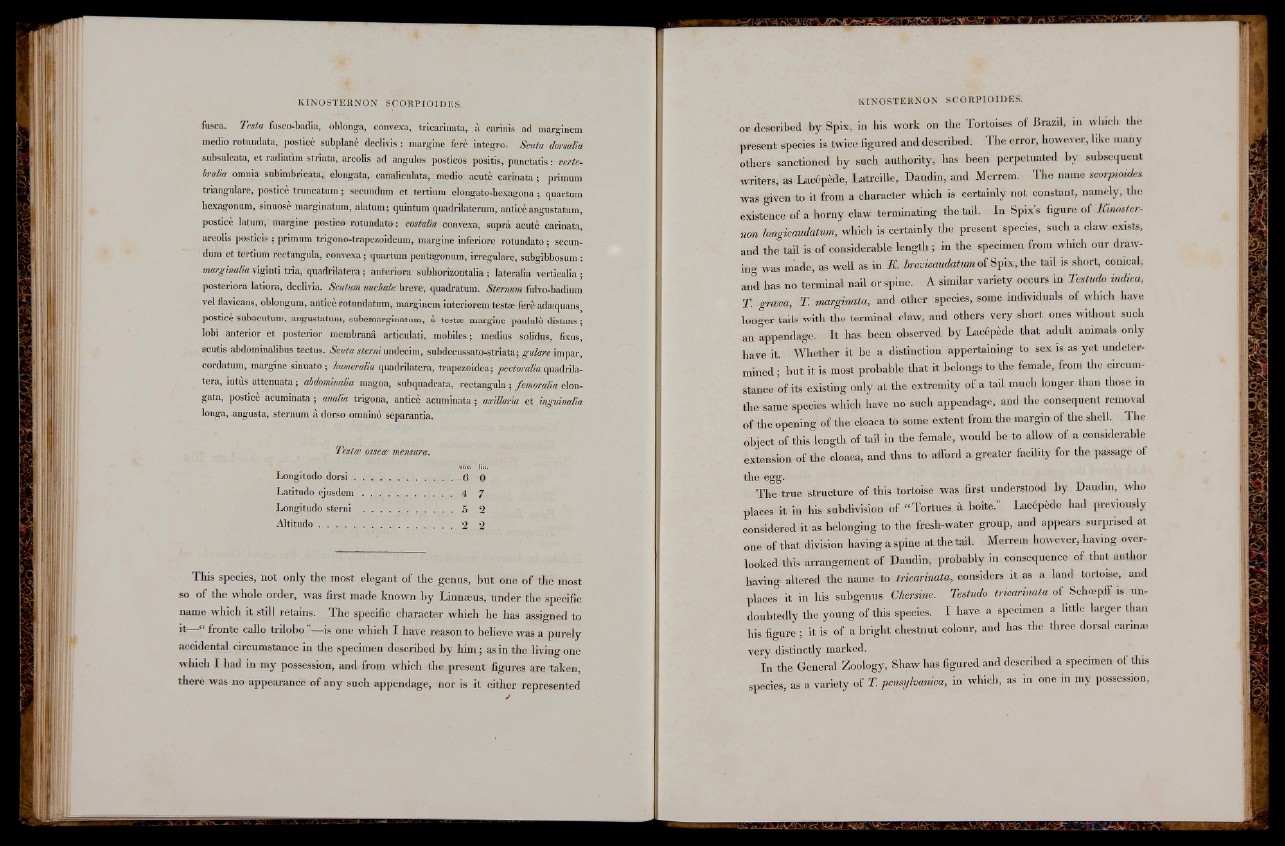
KINOSTERNON SCORPIOIDES.
fusca. Testa fusco-badia, oblonga, convexa, tricarinata, à carinis ad marginem
medio rotundata, postice subplane declivis : margine feré integro. Senta dorsalia
subsulcata, et radiatim striata, areolis ad ángulos posticos positis, punctatis : vertebrada
omnia sübimbricata, elongata, caiialicid'atai medio acute caricata ; primum
triangulare, postice truncatum ; secundum et tertium elongato-hexagona ; quartum
hexagonum, sinuosè marginatum, alatum; quintum quadrilaterum, anticéangustatum,
postice latoiti, margine pesticò rotondato : eostalia convexa, suprà acutè carinata,
areolis posticis ; primum trigono-trapezoideum, margine inferiore rotondato ; secundum
et tértium rectángula, convexa ; quartom pentagonum, irreguläre, subgibbosum :
marginalia viginti tria, quadrilatera ; anteriora subhorizontalia ; láteralia verticalia ;
posteriora latiora, declivia. Scutum nuchale breve, quadratoni. Sternum fulvo-badium
vel flavicans, oblongum, antico rotundatum, marginem interiorem testee feré adsequans
postice subaeutum, angustatum., subemarginatum, à testse margine paululó distans ;
lobi anterior et posterior membraná articulati, mobiles;, medius solidus, fixus,
scutis abdominalibus tectus. Scuta sterni undecim, subdecussato-striata; guiare impar,
cordatum, margine sinuato; humeralia quadrilatera, trapezoidea; peetnralia quadrilatera,
intus attenuata ; abdominalia magna, subquadrata, rectángula ; femoralia elongata,
postice acuminata ; analia trígona, antice acuminata ; accillaria et inguinalia
longa, angusta, sternum á dorso omninó separantia.
Testæ osseoe mensura.
ifríc.' lín.
Longitodo d o r s i........................................... 6 0
Latitado ejusdem . , 4 7
Longitudo sterni ................., , . . . . 5 2
A ltitu d e 2 2
This species, not only the most elegant of the genus, but one of the most
so of the whole order, was first made known by Linnæus, under the specific
name which it still retains. The specific character .which he has assigned to
it “ fronte callo trilobo -—is one which I have reason to believe was a purely
accidental circumstance in the specimen described by him; as in the living one
which I had in my possession, and from which the present figures are taken,
there was no appearance of any such appendage, nor is it either represented
KINOSTERNON SCORPIOIDES.
or described by Spix, in his work on the Tortoises of Brazil, in which the
present species is twice figured and described. The error, however, like many
others sanctioned, by such authority, has been perpetuated by subsequent
writers, as Laeep«-de, Latreille, Baudin, and Merrem. The name scorpioides
was given to it from a character which is certainly not constant, namely, the
existence of a horny claw terminating the tail. In Spix’s figure of Kinoster-
non longicaudatum, which is certainly the present species, such a claw exists,
and the tail is of considerable length ; in the specimen from which our drawing
was made, as well as in K. brevicaudatiim of Spix, the tail is short, conical,
and has no. terminal nail or spine. A similar variety occurs m Testudo indica,
T. grceca, T. marginata, and other species, some individuals of which have
longer tails with the terminal claw, and others very short ones without such
an appendage. It has been observed by Laeepcde that adult animals only
have it. Whether it be a distinction appertaining to sex is as yet undetermined
; but it is most probable that it belongs to the female, from the circumstance
of its existing only at the extremity of a tail much longer than those in
the same species which have no such appendage, and the consequent removal
of the opening of the cloaca to some extent from the margin of the shell. The
object of this length of tail in the female, would be to allow of a considerable
extension of the cloaca, and thus to afford a greater facility for the passage of
the egg.
The true structure of this tortoise was first understood by Baudin, who
places it in his subdivision of “ Tortues, k boite,” Laclede had previously
considered it as belonging to the fresh-water group, and appears surprised at
one of that division having a spine at the tail. Merrem however, having overlooked
this arrangement of Baudin, probably in consequence of that author
having altered the name to tricarinata, considers it as a land tortoise, and
places it in his subgenus Chersine. Testudo tricarinata of Schcepff is undoubtedly
the young of this species. I have a specimen a little larger than
his figure ; it is' of a bright chestnut colour, and has the three dorsal carin*
very distinctly marked.
In the General Zoology, Shaw has figured and described a specimen of this
species, as a variety of T. pensylvanicU, in which, as in one in my possession,